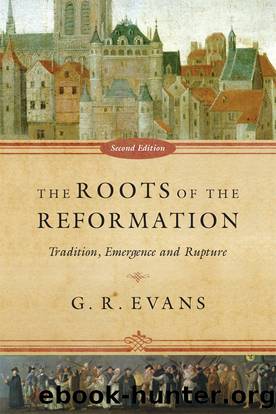The Roots of the Reformation: Tradition, Emergence and Rupture by G. R. Evans

Author:G. R. Evans [Evans, G. R.]
Language: eng
Format: epub
Publisher: InterVarsity Press
Published: 2012-08-01T16:00:00+00:00
Melanchthon, Moderation and Building a Bridge Between the Academic and the Popular
While Luther was at work in hiding, the University of Wittenberg was beginning a program of reform of its own andâas an academicâPhilipp Melanchthon was coming under a variety of pressures from students and colleagues.[9] Melanchthon began to think and write in defense of Luther with his customary calmness (and a restraint that led some to think him diffident). He also saw the advantage of creating a full, clear statement of the Lutheran position, amounting to a Lutheran theology, so that Lutherâs ideas would not look like mere reactions and scattergun responses to polemical challenges.
Melanchthon published a first version of his Commonplaces on Theological Themes or Loci Communes Rerum Theologicarum in 1521. It went through several iterations, the final version coming in 1555. Being systematic was always important to Melanchthon. He always tried to bring order, restraint and reason to Lutherâs energetically expressed views. This seems to have been done with no intention of self-aggrandizement, no rivalry with Luther, no ambition to create a âMelanchthonism.â His idea was to set out a series of statements in the highly respected style of the demonstrative method, with discussions accompanying each to provide proof and support. For example, Melanchthon begins the 1555 version of his Commonplaces with a first locus thus: âIn earnest invocation of God it is necessary to consider what one wants to address, what God is, how he is known, where and how he has revealed himself, and both if and why he hears our pleas and cries.â[10]
Melanchthonâs students probably started him on this project. It seems that the first version was an attempt to publish a correction to an unauthorized printing of his own lectures on Paulâs epistle to the Romans by some of his students.[11] This sort of thing had been the standard practice of the later medieval centuries, when students created a reportatio of lectures (with the masterâs permission), but in getting them printed they were adopting the new technology of the day and giving them a wider reach than could have been possible in the days of hand-copied manuscripts. In this way, the printing press was the Facebook or Twitter of its time.
The dissemination of the Loci, once Melanchthon published them on his own account, was energetic, with eighteen Latin editions and several German translations published within a few years. So the Loci Communes were direct products of the academic environment of Wittenberg in a new age, a deliberate polarization for the educated non-specialist reader.
The townspeople become involved. The discussion going on in the university and with the prince and the court was affecting ordinary people too. The heated atmosphere in Wittenberg also produced riots involving the townspeople, with images being smashed in the churches. The intensity of this was a phenomenon of a new era. Medieval dissidents had sometimes seemed to threaten civil unrest, but not on this scale. The Zwickau prophets, for example, who were millenarian extremists on the Anabaptist wing of the
Download
This site does not store any files on its server. We only index and link to content provided by other sites. Please contact the content providers to delete copyright contents if any and email us, we'll remove relevant links or contents immediately.
| Africa | Americas |
| Arctic & Antarctica | Asia |
| Australia & Oceania | Europe |
| Middle East | Russia |
| United States | World |
| Ancient Civilizations | Military |
| Historical Study & Educational Resources |
The Third Pole by Mark Synnott(914)
Money for Nothing by Thomas Levenson(896)
The Economist (20210109) by calibre(896)
Christian Ethics by Wilkens Steve;(824)
Made in China by Anna Qu(810)
The Age of Louis XIV: The Story of Civilization by Will Durant(788)
Reopening Muslim Minds by Mustafa Akyol(767)
Nonstate Warfare by Stephen Biddle(766)
100 Posters That Changed The World by Salter Colin T.;(750)
The Shortest History of China by Linda Jaivin(721)
The Great Pyramid Void Enigma by Scott Creighton(720)
Culture by Terry Eagleton(719)
The Irish Buddhist by Alicia Turner(715)
Ideology by Eagleton Terry;(696)
Routledge Handbook of Contemporary India by Knut A. Jacobsen(693)
Sybille Bedford by Selina Hastings(655)
The Jews of Silence: A Personal Report on Soviet Jewry by Elie Wiesel(650)
Objects of Vision by Saab A. Joan;(637)
Banaras: CITY OF LIGHT by Diana L. Eck(630)
